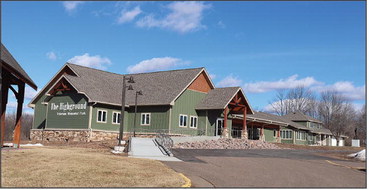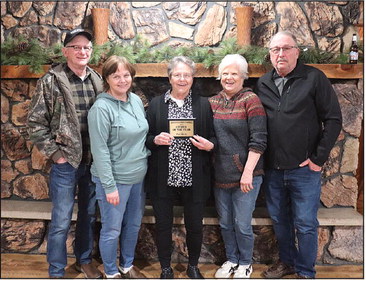Greenwood, Loyal administrators discuss consolidation referendum
By Valorie Brecht On Tuesday, voters in the Loyal and Greenwood school districts will be tasked with answering the question of whether they support the districts consolidating, or not. The non-binding, advisory vote will offer direction to the school boards of both districts as they determine the best course of action for the future of their schools.
Before the election, the Loyal and Greenwood school boards met with residents in a pair of informational meetings on March 16 and March 23 to answer any questions or concerns about the upcoming vote. Loyal School District Administrator ChrisLindnerandGreenwoodAdministrator Joe Green also met with the TRG to go over some of the most common questions related to consolidation. The following article has their comments, along with some school board members’ comments, organized by topic.
Location of schools According to information on both districts’ websites, the joint board has decided that discussions about facilities and potential changes to the structure of facilities will wait until after the districts consolidate.
“These two districts can consolidate and likely save a million or more dollars and no one has to change schools. We’re not looking at closing schools; we’re not looking at changing operation. The only thing that a consolidated district would look at is streamlining services, mostly duplicative positions, such as the superintendent role. I think there’s a big misunderstanding that consolidation equals closing school, and that’s just not the case,” said Green.
“Is it possible that a building closes down the road? Absolutely. But it doesn’t have to because of consolidation. The same time that you consolidate doesn’t mean that a building has to close… Consolidation does not mean closing a building. There are many different configurations and I think the districts as a whole, as a consolidated district, need to explore the effectiveness and efficiency once it’s consolidated,” he finished.
Lindner added that in conversations about consolidation over the past 60 years,
Please see Consolidation, page 8 Consolidation,
from p. 1
the location of the high school had always been the main sticking point. He said the school boards had held off on doing a facilities study because they wanted to get direction from the taxpayers before pouring more money into the issue. He said the upcoming vote was an advisory vote meant to give direction so the boards would have the go-ahead to start looking into more logistics of consolidation.
“This (the configuration of buildings) could stay status quo for a year, 2028-29, to figure out what is the best direction, and you’re still saving money. So there’s a lot of scenarios out there that can be taken a look at,” said Lindner.
Timeline If, on the upcoming ballot question, the majority of voters vote yes, the school boards would begin planning for consolidation. On Nov. 3, 2026, the boards could bring the question back to the public in a binding referendum vote. In December 2026, both boards would need to pass a resolution to consolidate, which if they did, would start an 18-month clock. During that time, decisions would be made as an interim joint board consisting of the members of both schools’ boards. The district would start as a consolidated district on July 1, 2028, with 2028-29 as first year as a consolidated district. In November 2028, an operational referendum would be placed on the ballot, as the districts’ current referenda will be set to expire by then.
A binding referendum vote is not a requirement for the districts to consolidate. In order to consolidate, the boards of both school districts simply need to approve a resolution to consolidate. However, if after both boards passed a resolution to consolidate, residents filed a petition signed by at least 10% of the electorate, then the school districts would have to put the question on the ballot as a binding vote.
Compatibility/other districts Baird, the consulting company that did the fiscal feasibility study for both districts, noted that Greenwood and Loyal were uniquely poised to consolidate because of neither district having debt, being so close to each other, and having similar mill rates.
“Baird hasn’t seen two districts that fit together as well as Loyal and Greenwood,” said Lindner.
At the Loyal meeting, parent Bucky Deegan had asked about working with other school districts or adding them into a consolidated district. Administrators said there had been some movement towards collaboration, at least. There has already been some sharing of music and sports programs between Greenwood and Granton.
The Granton Area School District is planning on aligning its school calendar with Greenwood’s and Loyal’s for next year, so they have the same days off. Lindner and Green said they had had some discussions with Granton’s district administrator as well.
Green said there would be nothing prohibiting a consolidated Loyal-Greenwood district from joining with other districts in the future; however, there would be other factors that would go into it. For example, the Granton and Owen-Withee school districts have debt. The mill rates of neighboring school districts also are not as close.
“So when you consolidate districts and one has debt, then that debt or that tax burden gets spread out. So you have winners and losers. So that’s why we go back to some of the Baird work. Loyal and Greenwood would fit well, and adding more districts could complicate it. Not to mention trying to figure some things out with two districts is challenging enough,” said Green.
“But it’s true that whether we’re in a consolidated district or on our own, I agree that we need to open our doors to all our neighbors. So if one district has something another one could benefit from or use, it’s there,” he added.
Opportunities Loyal resident Viki Pieper asked what additional opportunities would be created for students by consolidating that students didn’t already have available to them.
“This is something I’d love to dig into more if this is the direction we’re going, but let’s say when you have two districts that are offering trig or calc and you have four or five kids in each, both districts offer those classes. But once you say, ‘OK, now I have one class of 12 or 15,’ now you just freed up the teacher to teach something new. That’s just a math example. Maybe it’s a tech school dual credit class that they didn’t have time to teach before. Maybe it’s a language arts or communications class. Do they have opportunities to do some of those? They have some opportunities through the CWETN network and things like that. It also costs money. If we’re able to take a look at our own staff who are highly skilled and provide some of those classes so it frees them up to teach other classes, it also could be cost savings for districts,” said Green.
Consolidation would offer more technical college course opportunities. If the school districts were to consolidate, taxpayers would stay in the same technical college districts. Loyal people would continue to have a portion of their property tax go to NTC while Greenwood people would see a portion of their property taxes go to CVTC. However,studentsenrolledintheconsolidated district would now have access to courses from both colleges and would be able to earn college credit from either one, which is not currently the case.
Board member Eliza Ruzic said consolidating would also provide students more opportunities for friendships and a bigger pool of peers so they can find someone they connect with.
Loyal board member Kirk Haslow said that another opportunity with consolidation would be ensuring enough numbers to run classes that otherwise might get cancelled.
Finances For both districts, about 50% of their revenue comes from operational referendums. The districts have had to continue to levy for a higher amount in order to meet rising expenses. In 2005, Greenwood passed a $500,000 operating referendum. That has grown to $1,725,000 in 2027. In 2014, Loyal passed a $195,000 operating referendum. That has grown to $1,500,000 in 2027.
As long as both districts continue to pass operational referendums, they will stay viable and not go bankrupt. However, if either district would fail to pass an operational referendum and not have those additional dollars, their fund balance would run out after two years, possibly three.
There would still be the need for an operational referendum as a consolidated district; however, Baird has estimated about $1 million in savings by consolidating, so that should reduce how much the district would need to levy for.
“The needs have become more, and with revenue going down and expenses going up, that’s why Mr. Green and I took a look at it,” said Lindner.
“To me, it’s pretty simple. In anyone I talk to in either community, taxes continue to go up. The cost of running a school and any other business continue to go up. There’s only a couple ways to remedy that. One way is to eliminate some expenses; the other is to figure out a more efficient way to operate. Consolidation is potentially a more efficient way to operate. We’re two school districts six miles apart with similar mill rates, similar issues with declining enrollment, zero debt. That is an option to run more efficiently,” said Green.
“The other way to try and balance the books and meet the needs of taxpayers is to figure out how to do what we need to do to meet the needs for our kids with less resources. I’m not sure that’s feasible in a world with growing needs… I don’t know that we can continue to offer the programs and support our kids and trim our expenses. I’m not sure that’s possible.
“Are there are things that are logistical concerns that come into play when we talk about consolidation? Of course. There are a lot of things that we worry about. But those are all things that with two communities that care a ton about their kids — put those two communities together and I’m quite certain we can figure out a solution that benefits our kids,” he said.
Enrollment numbers Greenwood’s enrollment has leveled out in recent years. Loyal will be facing a significant drop in enrollment soon. The current Loyal enrollment is 480. After the sophomores and juniors leave, it will be down to around 435. Losing 45 students at $11,000 in state aid per student equals a revenue loss of $495,000.
District administrator Lindner and Green said the decision on who would serve as district administrator would be made by the joint school board. Green also said there were several duplicative positions that could be cut on the administrative side, such as office staff. However, he said he couldn’t give specifics on which positions, because that would be up to the joint board to decide. With the board election this April and another one in April 2026, the boards will be changing, anyway.
Board makeup If the school districts were to move forward with consolidation, during the 18-month period between when the boards passed a resolution to consolidate and when the districts actually consolidated, the two boards would operate as an interim joint board. During the Greenwood School District’s annual meeting in September 2026, the board would need to pass an
Please see Consolidation, page 9
?
GOT QUESTIONS?
For more questions and answers on the proposed consolidation of the Greenwood and Loyal school districts, see pages 10-11. ?
from p. 8
amendment to their policies to add two more board members to the board. That way there would be seven Loyal members and seven Greenwood members on the interim joint board.
As a joint board, they would have to decide what they wanted the consolidated school district’s board to look like, whether it would be composed of five, seven, or nine members, and how many members would represent a certain area of the new consolidated district or be at-large members. As an example, Loyal currently has members representing the area north of Highway 98 and the area south of Highway 98, so those areas would change under a consolidated district.
Consolidation Aid and Sparsity Aid A consolidated district would receive $150 per student for five years, then gradually reduced each year. At around 750 students when combined, that would be $112,500.
“It’s nowhere near what they used to give for consolidation, but still something,” said Green.
To receive Sparsity Aid, the school districts have to have less than 745 or 750 students enrolled in all. Green said that he had previously thought the districts would lose out on that by combining, but looking at enrollment numbers K-8, it would be between 50 to 60 students per grade, so the overall enrollment would likely be low enough that the combined district would still get Sparsity Aid.
Concerns The biggest concerns that have come up so far are transportation and students being on the bus longer, the location of the schools, and colors/mascot/name of the school.
“Those are things that I believe can get figured out. We’re just asking for your advisory vote on, do we continue moving forward and continue that process?” said Lindner.
One Loyal parent, Grace Genteman, asked if the districts had taken into account the number of students that would be lost under a combined district because they were on the fringes and would open enroll to another closer adjoining district such as Spencer, Owen-Withee, or Neillsville.
“That’s an absolutely fair question. I think the opposite can be said too of what do we stand to gain. I try to be more of an optimist in looking at this. By pooling our resources and becoming a district that’s bigger and stronger, we know that there’s districts not so far away that also struggle. What do we stand do gain if we’re able to put a more dynamic opportunity in front of our kids? Some of the kids that are on the fringe, do we have just as much an opportunity to attract as we do to lose them?” asked Green.
“As a parent, I live as far away as you can and still be in our school district. I live 12 miles to the west out in God’s country, right? I’m going to send my kids, or my son who would still be in school if those goes into effect, I’m going to send him to the place that gives him the best opportunity to be successful down the road. And I think if we we keep our eyes on the prize, I think that’s to offer a more dynamic, robust opportunity for our kids. And I would hope parents make decisions to send their kids where the kids are going to have the most opportunities to prepare them for a better future. And if that means six more miles? I don’t see transportation myself as a barrier. I see, what are the opportunities we can build by sharing resources and making stronger?”
Loyal school board candidate and parent Crystal Rueth said she wasn’t sure what to think on consolidation and she had friends both for and against it. But she said she did have concern about maintaining the quality of education.
“I feel like my kids are already in the best place for them. I chose Loyal. We moved here from a different area 15 years ago and we picked the school here… My kids are thriving here. A fear that I have is what happens if we consolidate and it isn’t what we had hoped for? And there’s no easy answer or stat for that. I already feel like we chose this district and this is where my heart is, where my kids are thriving, and we love it here. So it’s hard to think about what it would be like if it’s anything but what we have. And again, I’m not saying I’m against it, but that is my fear is what if we consolidate and it’s not what we hoped, and I see my little ones not thriving like my older kids did.”
“How I would answer that is, if you think you’re getting a good education in Loyal, and I think the parents in Greenwood would say their kids are getting a good education, it’s hard to imagine that putting together a good education and a good education we would end up with a bad education. I don’t see that as a possibility,” said Loyal board president Dennis Roehl. “I think we both offer a good education, and I think we can do better. I think we should always be striving to better and keeping a positive attitude toward all this. If everyone’s pushing towards a common goal, it’s kind of hard to fail if everyone’s pushing. We know we’re going to have to change things. Nothing’s going to work out perfectly the first time you do it. But I think both boards and both school districts are willing to try, and I think that’s all we can do.”
Board member Dean Lindner from Greenwood said what’s motivated him to look at consolidation is avoiding what has happened to some neighboring districts that have failed to pass a referendum.
“Those are scary conversations, because then you’re talking staff and losing opportunities. I’d much rather control my future and build a stronger school together and create opportunities,” said Lindner.
He said his other main concern was staffing, as when he started on the school board years ago, there were dozens of applicants for a position and now they often had trouble finding anyone. So with a larger district, there is larger pool of staff to draw from.
The district administrators encouraged people to reach out if they had any other specific questions or concerns. Lindner can be reached at chrislindner@loyal.k12.wi.us or 715-255-8552, and Green can be reached at jogreen@greenwood.k12.wi.us or 715-267-6101.
“The superintendents in the state are watching what our two districts are doing right now. They understand that we share a lot and we do a lot of things together. They’re interested in seeing where this goes and what direction our students go. Because I do believe there are more districts looking at doing this,” said Lindner.



